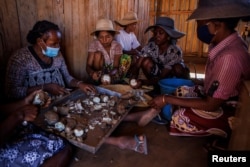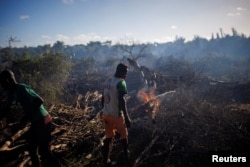With few trees left to slow the wind in southern Madagascar, sand blows continuously. It settles across fields, villages, roads and in the eyes of hungry children waiting for food aid.
Four years of extremely dry weather and forest clearing to make farmland have turned the once fertile area into a dusty red emptiness.
"There's nothing to harvest. That's why we have nothing to eat and we're starving," said Tarira. The mother of seven waited at the World Food Program (WFP) center near Anjeky Beanatara. She was there to get Plumpy, a dense peanut-based food provided to starving children. The UN agency said more than a million people in southern Madagascar currently need help from the WFP.
Holding her four-year-old son Avoraza by his thin arm, she said, "There are seven, so there wasn't enough food. The Plumpy wasn't enough for him.”
Like many others in the area, Tarira and her family have sometimes eaten a local plant called raketa. The plant grows in the wild but provides few valuable nutrients, she said, adding that eating it can cause stomach pain.
Madagascar is the fourth-largest island on Earth and it contains one of the planet’s most diverse ecosystems. It has thousands of species of colorful plants and wild animals. But, it is not all a natural, green paradise. Especially in the south, the environmental reality on the island has changed.
"We used to call Madagascar the green island, but sadly now it is more of a red island," said Soja Lahimaro Tsimandilatse, governor of the southern Androy area.
Praying for rain
The food crisis in southern Madagascar grew over several years. Officials and aid organizations point to a mix of causes: drought, deforestation, other environmental damage, as well as poverty, COVID-19 and population growth.
Madagascar is home to 30 million people. It has always been a place of extreme weather. But scientists say climate change and its fast-increasing temperatures are worsening the situation quickly.
At the height of the food crisis in the south, the WFP warned the island was at risk of seeing "the world's first climate change famine."
Theodore Mbainaissem runs WFP operations in southern Madagascar. He said there are no usual weather patterns any longer. Villagers can no longer predict the best time to plant or harvest.
He said the WFP, other aid organizations and local government have worked to limit the food crisis. He said severe malnutrition among children had dropped from about 30 percent a few months ago to about 5 percent now.
"When you look in the villages, you see children running left and right. That wasn't the case before," he said.
Local communities are now working on forward-looking projects like an effort to protect hills of sand along the coastal town of Faux Cap.
But in rural areas where people live in poverty, the crisis grows. Felix Fitiavantsoa was burning down a wooded area to start farming. He and his new wife had to eat. His main worry was whether it would finally rain so he could get started.
"If there's no rain, I don't know what we'll do. We'll pray to God," he said.
I'm Susan Shand.
Alkis Konstantidinis and Christophe Van Der Perre reported this story for Reuters. Hai Do adapted the story for Learning English.
__________________________________________________________________
Words in This Story
diverse - adj. different from each other
species - n. a group of plants or animals that are similar
drought - n. a long period with little or no rain
pattern - n. a regular and repeated way in which something happens












